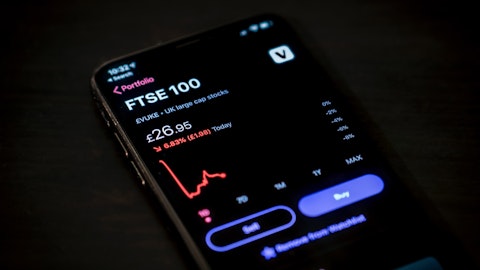Conn’s, Inc. (NASDAQ:CONN) Q3 2023 Earnings Call Transcript December 6, 2022
Operator: Good morning, and thank you for holding. Welcome to the Conn’s, Inc. conference call to discuss earnings for the fiscal quarter ended October 31, 2022. My name is Daryll, and I will be your operator today. . As a reminder, this conference call is being recorded. The company’s earnings release dated December 6, 2022, was distributed before market opened this morning and could be assessed via the company’s Investor Relations website at ir.conns.com. During today’s call, management will discuss, among other financial performance measures, adjusted retail segment operating income, adjusted retail segment operating loss, adjusted net loss per share and net debt. Please refer to the company’s earnings release that was issued today for a reconciliation of these non-GAAP measures to their most comparable GAAP measures.
I must remind you that some of the statements made in this call are forward-looking statements within the meaning of federal securities laws. These forward-looking statements represent the company’s present expectations or beliefs concerning future events. The company cautions that such statements are necessarily based on certain assumptions, which are subject to risks and uncertainties, which could cause actual results to differ materially from those indicated today. Your speakers today are Norm Miller, the company’s interim CEO; and George Bchara, the company’s CFO. I would now like to turn the conference call over to Mr. Miller. Please go ahead.

marie-michele-bouchard-SN6HW62ubLA-unsplash
Norman Miller: Good morning, and welcome to Conn’s Third Quarter Fiscal Year 2023 Earnings Conference Call. I’ll start today’s call with a review of the quarter and an update on our strategic priorities before turning the call over to George, who will review our financial results in more detail. I am excited to rejoin the company’s leadership team, and I look forward to reengaging with our shareholders and analysts. As a reminder, I previously served as Conn’s CEO and President from 2015 to 2021 and have been a member of the Board since 2015. After a little more than a month since being appointed interim CEO and President, I want to start today’s call with my assessment of the business. I believe Conn’s continues to benefit from a strong foundation, committed management team and powerful value proposition.
We also have a compelling strategic growth plan focused on strengthening our core retail business, leveraging our credit business and accelerating eCommerce growth. However, Conn’s business model is complex and requires leadership, focus and discipline, which is especially critical in today’s macroeconomic environment. With a renewed focus on execution, I believe our financial performance will improve and we can reestablish a disciplined approach to profitable and sustained growth. I am also confident in Conn’s core value proposition and, as one of the company’s largest individual shareholders, I am committed to creating lasting value for all of the company’s stakeholders. Conn’s is in a much different position today compared to when I joined the company as CEO back in 2015 where we lacked the platform to successfully manage our complex business model, digest the rapid growth we had experienced and effectively operate our credit segment.
To respond to the challenges in 2015, we built a proper infrastructure focused on profitability and developed a foundation for growth. The successful execution of these actions expanded the company’s operating margins from 7% to 12% and increased the company’s book value by 40%. Today, I believe our business is supported by a sophisticated credit operation and experienced leadership team. We are quickly reestablishing a disciplined approach to growth and profitability. This includes taking actions to reduce our cost structure and enhance our cash flow while managing inventory levels and optimizing our business. We are also refocusing our efforts to better serve our core credit-constrained customers, and we believe our differentiated credit offerings are needed now more than ever.
As you will hear later in my prepared remarks, we remain focused on pursuing the growth strategies already underway while expanding our focus on the Conn’s core financed customer. Finally, to our shareholders, customers and team members listening to today’s call, I believe Conn’s will return to a profitable and growing organization as our execution improves. So with this overview, I’d like to review our third quarter performance in more detail before updating you on our strategic priorities. Our retail sales performance was disappointing, as multiple factors caused same-store sales to decline 27% during the third quarter. First, we continue to lap atypically strong retail results from last year, which benefited from stimulus programs and pull forward of demand.
Second, we believe current year demand is being impacted by changing consumer behavior as inflationary pressures and recessionary fears have caused consumers, especially lower-income consumers, to shift spending away from the discretionary home-related products we sell. Finally, lower year-over-year lease-to-own sales and a shift to focus away from our core customer compounded the external challenges we faced during the third quarter. Efforts underway to refocus on our core finance customers are supported by the investments we have made to build and manage a leading credit organization. As a result, the underlying quality of the portfolio remains stable even as we experience normalizing credit trends. In fact, we have seen continued improvements in the weighted average credit score of both originations and outstanding balances, reflecting our ability to target a more favorable mix of higher credit quality customers.
In addition, the carrying value of re-aged accounts continues to improve and remains at one of the lowest levels since 2014. However, the decline in retail sales has reduced our portfolio balance, which has impacted finance charges and other revenue and will temporarily impact delinquency and loss rates. To offset the reduction in retail sales and credit revenue, we are aggressively managing costs, and we have taken actions over the past 6 months that are expected to generate annualized cost savings of approximately $20 million to $30 million. We are working to mitigate the impact this will have on profitability, and we expect the cost saving actions implemented this fiscal year will help partially offset higher incremental operating costs next year.
Additionally, we are carefully managing inventory levels, and we have delayed or eliminated certain previously planned capital expenditures, including our rebranding initiative. As a result of these actions, we anticipate CapEx for fiscal year 2023 to be between $70 million to $80 million compared to expected CapEx of $90 million to $100 million, which we disclosed at the start of the fiscal year. Keep in mind, we believe operating costs will increase next fiscal year because of store and distribution center expansion plans already committed. This includes a new distribution center in the Southeast, the relocation of a Texas distribution center and the addition of approximately 10 new stand-alone locations next fiscal year. As a reminder, it takes approximately 12 months to open a new store, while a new distribution center takes approximately 18 months to open.
We also recently worked with our supportive bank partners to amend our credit facility, which resulted in 6 quarters of covenant relief. This will provide us with additional flexibility to turn around our financial performance and implement our in-house lease-to-own strategy. As a result, we believe we have the financial resources needed to simultaneously navigate near-term retail conditions and stabilize the business while supporting our long-term growth initiatives. While there is work to be done to drive top line growth, transform our cost structure and return to profitability, I believe Conn’s underlying value proposition continues to resonate with our core customers and supports a significant growth opportunity. In fact, Conn’s unique credit retail business model was built over 50 years ago to help customers purchase products for their homes during challenging boom and bust cycles in the Texas oil and gas market.
Our business model has successfully proven itself time and time again throughout multiple business cycles. As we refocus on our core customer, I believe our legacy of performance and unwavering support for our customers during times of hardship will drive sales opportunities and generate lifetime customer value. We are also entering a period of tightening throughout the credit markets, which we believe will drive higher credit quality customers to Conn’s. Furthermore, we expect consumers’ credit scores will start to decline as government stimulus programs have ended and consumers are faced with higher inflation and greater economic uncertainty. As these market trends increase the need for the financing options we provide, I am confident we have significant opportunities to capture customers across the credit spectrum.
Actions underway to reemphasize our core value proposition are focused on enhancing our marketing efforts, leveraging the sophistication of our credit platform and ensuring our retail strategies and sales execution support customers along their in-store and online journeys with Conn’s. I also want to be clear that we will remain disciplined in our underwriting approach. In fact, I believe we are better positioned today than any time in our history to simultaneously support retail sales while managing credit risk. This is due to our best-in-class credit offerings, which includes our private label credit card, our in-house financing option, our lease-to-own program and our new Layaway payment plan. The integration of the in-house lease-to-own platform we acquired in the first quarter is progressing, and we expect to originate our first in-house lease-to-own sales early next calendar year.
The transition to an in-house lease-to-own platform is a key growth initiative. And as the program matures, we expect it will be highly accretive to profitability. In addition, we believe this program will support our lease-to-own sales growth expectations while allowing Conn’s to maintain disciplined underwriting standards. As a result, we believe our in-house lease-to-own platform has the potential to be a transformational driver of future growth and profitability. Overall, we believe our best-in-class credit offering support a powerful and differentiated platform. As our attention returns to this area of the business, I am confident in the multiple levers we have across our internal and external credit offerings to drive profitable sales growth.
Next, I want to provide an update on the progress we are making transforming our eCommerce business. Throughout the year, we have completely re-platformed our website to a modern cloud-based infrastructure that offers consumers updated search, browse and checkout features. We have also expanded our online assortment, leveraged our next-day white glove delivery capabilities and provided in-store associates with the capabilities to add online-only items to in-store transactions. Year-to-date, eCommerce sales have increased 16.7% to $55.1 million, while third quarter sales declined 8.9% to $17.5 million as a result of a shift of focus from our Conn’s core financed customer and the re-platforming actions we completed during the quarter. I am pleased to announce that we are nearly finished with our eCommerce transformation, and we are working on implementing the last phase, which is focused on enhancing the digital application process.
With all online transactions now running on our new platform, we have seen eCommerce sales improve, with sales for the month of November up year-over-year. Going forward, we believe we have a large opportunity to grow online sales, and we are committed to driving traffic and increasing conversion. In addition, we are focused on creating a best-in-class eCommerce platform that offers credit-constrained consumers the ability to apply for and get approved for credit online. We believe that with the terms of our in-house financing program, our 100% digital approval process will be unlike any other credit offering in the marketplace once fully implemented. As a result, we expect our new eCommerce platform to produce sustainable growth over the next several years.
Turning to our partnership strategy. We believe our unique capabilities are attractive to a variety of retailers looking to leverage our core strengths while providing opportunities to expand our addressable market. During the third quarter, we added 15 Belk store-within-a-store locations, bringing the total number of Belk locations to 19. In addition, we launched an eCommerce experience on belk.com, which completes the initial rollout under this pilot program. While our test with Belk is just getting started, this partnership provides us with a potentially efficient way to grow our footprint into new markets and serve more fast and reliable consumers. As you can see, we are quickly implementing actions to refocus our efforts and better serve our core credit-constrained customers and control costs as we continue to make progress against our strategic initiatives.
As we focus on successfully executing against these priorities, we believe we will significantly improve our financial results. Finally, with a little over 30 days since rejoining the leadership team and in lieu of official guidance, I want to provide some details on our fourth quarter performance. Same-store sales for the month of November were down 24.8%, better than the third quarter and represents 2 consecutive months of same-store sales improvements. Heading into the final weeks of the calendar year, we believe our merchandising and marketing strategies are aligned with our refocused credit approach and consumer trends. In addition, we continue to prudently control inventory. As of October 31, 2022, inventory has declined 1.5% year-over-year despite a 5% increase in the number of Conn’s locations and the rollout of 19 store-within-a-store locations at Belk.
Before I turn the call over to George to share more details on our financials, I want to reiterate my strong confidence in our business. Conn’s continues to have a unique value proposition, solid foundation and compelling future. I believe we have the right strategies in place to drive top line sales and improve our financial results, especially as retail trends normalize. We can and should win in any environment, and the leadership team and I will hold the company accountable to this belief. As we refocus on execution in the business, I am confident we can turn around our financial and operating results. I have a deep conviction that our business resonates with our customers and a strong belief in our leadership team’s ability to deliver on our strategic priorities.
With this overview, I’ll turn the call over to George.
See also 10 Best Fundamental Stocks To Invest In and 10 Best Ethanol Stocks To Invest In.
George Bchara: Thanks, Norm. Before I begin, I want to welcome Norm back to the company’s leadership team. On behalf of everyone at Conn’s, we look forward to Norm’s focus on execution as we work hard to turn around our performance and create sustainable value for our customers, team members, communities and shareholders. On a consolidated basis, total revenues were $321.2 million for the third quarter of fiscal year 2023, representing a 20.8% decrease from the same period last fiscal year. For the third quarter, the company reported a GAAP net loss of $1.04 per diluted share compared to net income of $0.60 per diluted share for the same period last fiscal year. On a non-GAAP basis, adjusting for certain charges and credits, we reported a net loss of $0.78 per diluted share for the third quarter compared to net income of $0.60 per diluted share for the same period last fiscal year.
Reconciliations of GAAP to non-GAAP financial measures are available in our third quarter earnings press release that was issued this morning. Looking at our retail segment in more detail. Total retail revenues for the third quarter were $254.6 million. The 24% year-over-year decline in retail revenue was driven primarily by the trends Norm discussed in his prepared remarks, including an atypically strong retail results last year, the impact inflationary pressures and recessionary fears are having on consumers’ behavior this year, lower year-over-year lease-to-own sales and a shift of focus away from our core customer. We opened 2 new stand-alone stores during the third quarter, bringing the total store count to 165 in 15 states. During the fourth quarter, we plan to open 4 additional locations, which will add a total of 11 new stand-alone locations in fiscal year 2023.
We also opened 15 store-within-a-store pilot locations with Belk during the third quarter. The 19 store-within-a-store locations we’ve opened this fiscal year reflects our initial pilot of Belk, and we look forward to continuing to test our retail partnership strategy. Retail gross margin for the third quarter was 33.2% compared to 36.8% for the same period last fiscal year, a decline of 360 basis points. The year-over-year decrease in retail gross margin was primarily driven by deleveraging of fixed distribution costs from lower sales and higher freight costs. While we expect retail gross margin to remain under pressure over the near term, as retail sales recover and we realize the benefit of lower international shipping costs, we expect retail gross margin to improve over time.
SG&A expenses in our retail segment decreased by 6.7%, driven by declines in variable costs, bonus expense and advertising and labor costs as a result of cost savings initiatives. These decreases were partially offset by an increase in occupancy and operational costs due primarily to new store growth. Due to lower retail sales, SG&A expenses were 37% of retail sales for the third quarter compared to 30.2% for the same period last fiscal year. For the 3 months ended October 31, 2022, retail segment operating loss was $17.7 million compared to Retail segment operating income of $22.5 million for the same period last fiscal year. On a non-GAAP basis, adjusted retail segment operating loss for the third quarter was $9.7 million after excluding a charge for employee severance.
This compares to non-GAAP adjusted retail segment operating income of $22.5 million for the same period last fiscal year. Turning to our credit segment. Finance charges and other revenues were $66.6 million for the third quarter, a 5.7% decline from the same period last fiscal year. The decrease in finance charges and other revenues was primarily due to a 7.3% decrease in the average outstanding balance of the customer accounts receivable portfolio as well as a decline in insurance commissions. The decrease was partially offset by an increase in late fee revenues. Recent credit trends reflect a smaller portfolio balance, which is impacting delinquency and charge-off rates. In addition, recent credit performance is up against large-scale stimulus programs, which supported better payment delinquency and charge-off performance over the past 2 years.
As we navigate these normalizing trends, we believe underlying credit quality remains stable and reflects our conservative credit underwriting approach. As a percent of the portfolio, the 60-plus day past due balance was 12.2% at October 31, 2022, which was impacted by the decline in our portfolio balance, normalizing credit trends and a more restrictive re-age policy. This compares to 8.8% for the same period last fiscal year, which benefited from stimulus programs. The balance of re-aged accounts as a percent of the portfolio was 16.5% compared to 18.3% for the same period last fiscal year. For the third quarter, annualized net charge-offs as a percent of the average portfolio balance were 13.7% compared to 8% for the same period last fiscal year.
We estimate the decline in our portfolio balance had around 100 basis point impact on the 60-plus day delinquency and charge-off rates at the third quarter ended October 31, 2022. Despite higher annualized net charge-offs during the third quarter, our credit spread for the 3 months ended October 31, 2022, was 9.8% compared to 14.6% for the same period last year. We expect our credit spread will decline in the near term as a result of a smaller portfolio and as credit trends continue to normalize. During the third quarter of fiscal year 2023, the credit provision for bad debts was $34.8 million compared to $26.5 million for the same period last fiscal year. The $8.3 million increase in credit provision for bad debts was primarily driven by a smaller year-over-year decline in the allowance for bad debts and the year-over-year increase in net charge-offs.
The company reported a credit segment loss before taxes of $11.8 million compared to credit segment income of $1.8 million for the same period last fiscal year. The reduction in credit segment income before taxes was primarily due to lower credit segment revenue, a higher provision for bad debts and an increase in interest expense, partially offset by lower SG&A expenses. Turning now to our balance sheet. At October 31, 2022, we had $538.7 million in net debt compared to $424.1 million for the same period last fiscal year. Net debt as a percent of the ending portfolio balance was approximately 52.2% at the end of the third quarter, which remains below pre-pandemic levels. In addition, we have no near-term debt maturities. And earlier this year, we successfully completed our 11th ABS transaction since reentering the ABS market in 2015.
Our ABL group continues to be supportive of our business and the strategies we are pursuing to improve our performance and reestablish our growth trajectory. We recently worked with our bank partners to amend our credit facility to provide us with the additional flexibility to successfully turn around our financial performance and navigate the current retail environment. This resulted in 6 quarters of covenant relief, which also provides us with enough time to complete the transition of our in-house lease-to-own strategy. In addition, to enhance our liquidity profile, we recently sold the 2022 Class C note. As of November 30, our cash plus availability under our ABL was $222.2 million compared to $163.8 million at October 31. Overall, we continue to believe our liquidity and access to capital provides us with the flexibility to support the current needs of our business while investing in our long-term growth initiatives.
As part of the leadership change and continued macroeconomic and retail uncertainty, we previously withdrew our fiscal year 2023 financial guidance. We are confident in the company’s value proposition and the priorities we are pursuing to turn around our financial performance and drive profitable and sustainable growth. Finally, I want to share my thanks to all our team members for their continued hard work, service and dedication. So with this overview, Norm and I are happy to take your questions. Operator, please open the call up to questions.
Q&A Session
Follow Conns Inc (NASDAQ:CONN)
Follow Conns Inc (NASDAQ:CONN)
Operator: . Our first question is coming from the line of Kyle Joseph with Jefferies.
Kyle Joseph: A lot of moving parts, obviously, with macro and kind of the mix shifts in the book. But just kind of want to get your expectations for near-term and intermediate-term credit performance and how you see net charge-offs kind of shaking out versus historical averages.
Norman Miller: George, you can chime in after I finish. What I would tell you, Kyle, is we’re pretty pleased with where — as I’ve come back and really dug into the portfolio, pretty pleased with the performance of the portfolio. Clearly, we’re seeing a normalizing of credit trends from the atypical performance we saw a year ago. But when we look at the delinquency buckets and the roll rates, pretty pleased with what we’re seeing from a historical comparison standpoint. Typically, in the fourth quarter, we see historically more elevated charge-offs, that’s typical with seasonality and the timing from the tax season when those accounts roll off at the end of the year. I would say we’re seeing that similarly here. But as I look at the early part of the buckets, and we’re pretty bullish. Now obviously, the macroeconomic piece can change that. But as we sit here today, pretty bullish about where the portfolio is looking in the first part of next year.
George Bchara: Only thing I’d add to that, Kyle, is we talked about this a bit in our prepared remarks, it’s just the denominator effect of the shrinking portfolio and the impact that has on the charge-off rate. So in the fourth quarter specifically, even though we’re not providing formal guidance, we would expect to see the charge-off rate to be higher than it was in the third quarter for the factor that Norm just described around seasonality as well as the denominator effect.
Kyle Joseph: Got it. Sorry, go ahead, Norm.
Norman Miller: I was just going to say and as George said in his prepared remarks, that denominator effect with the shrinking Conn’s portfolio is a material impact on the rates. And we’re estimating it, it’s 100 basis points impact you see from a rate. Now frankly, I focus more on the actual dollar amount of charge-offs because that’s the real driver at the end of the day. But clearly, we need to — as we refocus on the Conn’s customer, we need to see our portfolio start to grow again. It not only will fix or help address the rate issue that we have from a charge-off and delinquency standpoint, but it also will help from leveraging — from the deleveraging we’ve been seeing with margins and other factors with the smaller portfolio.
Kyle Joseph: Got it. Helpful. And then moving over to Belk. Any numbers you can share? I know it’s relatively early, but you rolled out another 15 locations and just give us a sense for what the potential is with Belk and then remind me if you guys are able to offer Conn’s credit in these locations.
Norman Miller: So what I would say is it’s very — I mean literally, 15 of them — the 19 rolled out here in the third quarter. And the belk.com, the website, our products being available on their website only went live in the month of October. So it’s very early. I’d be leery to give you any hard numbers. We expect to be able to give you some direction when we report at the next quarter. But what I’d say is, I think as I’ve looked at those stores and looked at the opportunity there, there’s real opportunity there for us, real potential there to increase our addressable market. And then the question on Conn’s financing, we don’t currently offer that in the stores. They do have a high credit quality offering, but no Conn’s credit or no lease-to-own opportunity in the Belk stores. But that is something, as we continue to see the test unfold, there could be potential opportunity down the road as we work with our Belk partner.
Kyle Joseph: Got it. And then just one last one from me on the lease-to-own product as you guys think about beginning to originate your own transaction. Just give us a sense for high level how this would compare to kind of the product offering of third parties? Are you guys going to offer early buyouts and any kind of differences in terms of economics to the consumer there?
Norman Miller: No. I think you’ll — and again, we’ll share, as we expect, to start writing our first lease agreements here in the first quarter. We’ll share particulars on what those — what that financial agreement with the consumer will be. But we have patterned it very similarly to what you see with other virtual and bricks-and-mortar lease-to-own products that are out there in the marketplace. We recognize that we are competing with them with that product.
Operator: Our next questions come from the line of Brian Nagel with Oppenheimer.
Brian Nagel: So Norm, welcome back.





